DeFAI is the new DeFi: List of related projects about what DeFAI is

Reprinted from jinse
01/06/2025·5MAuthor: 0xJeff, manager of Steak Studio; Translator: Golden Finance xiaozou
DeFi has always been the backbone of Web3. It is DeFi that highlights the practicality of blockchain, which provides us with the tools needed to achieve instant remittances, on-chain asset investments, intermediary lending, and cross-DeFi protocol strategies on a global scale. These are financial freedoms within reach.
More importantly, DeFi solves real-world problems. It enables those without traditional bank accounts to access financial services, eliminates middlemen, and operates around the clock, creating a truly globally inclusive financial system.
But let’s face the obvious together: DeFi is really complicated .
Setting up a wallet, managing gas fees, and learning to avoid lightning in an environment where fraud is rampant - is not very user-friendly. Increasing L1, L2 and cross-chain ecosystems will only make things more difficult. The barrier to entry is too high for most people.
It is this complexity that has hindered the growth of DeFi, but DeFAI is starting to change that.
What is DeFAI ?
DeFAI (DeFi + AI) makes DeFi accessible. DeFAI uses artificial intelligence to simplify complex interfaces and eliminate the difficulty that hinders ordinary people from participating. Imagine a world where managing your DeFi portfolio is as easy as chatting with ChatGPT.
The first wave of DeFAI projects has now emerged, focusing on three areas:
-
abstraction layer
-
autonomous trading agent
-
AI-driven dApps
1. Abstraction Layers
The purpose of the abstraction layer is to make DeFi more accessible by hiding its complexity behind an intuitive interface. The abstraction layer enables users to interact with DeFi protocols using natural language commands without having to use complex dashboards.
Before the advent of artificial intelligence, abstraction layers like intent-based architecture simplified transaction execution. Platforms such as CoWSwap and SYMMIO solve the problem of liquidity fragmentation by enabling users to access the best pricing in decentralized liquidity pools, but they do not solve the core problem: DeFi remains prohibitive.
Now, artificial intelligence solutions are filling this gap:
- Griffin is the first solution to launch a token, and the product is still in early access and users need to be invited to access it. Griffin is more versatile, allowing users to perform various basic or complex operations, such as task automation (DCA), publishing meme coins, and airdropping meme coins according to standards.
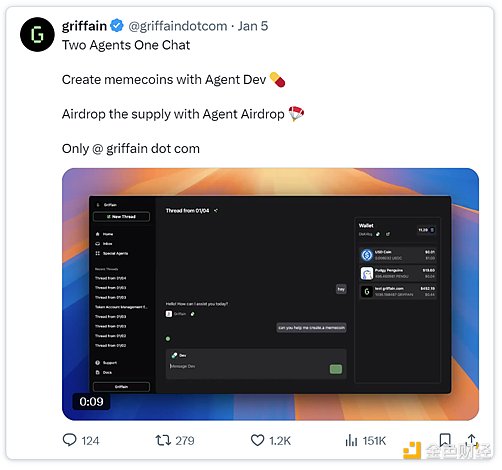
- Orbit/Grift is the second token-issuing solution geared towards the on-chain DeFi experience. Orbit emphasizes cross-chain functions and integrates more than 200 protocols from more than 117 chains, which is the most integrated among the three solutions.
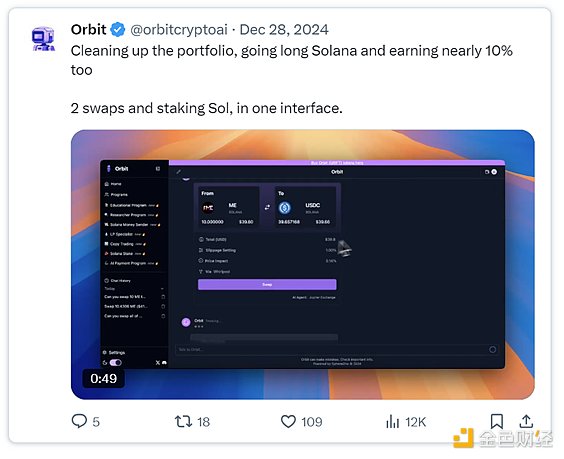
- Neur was the third solution to be released, but quickly surpassed Orbit in valuation due to its open source nature. Neur positions itself as a Solana co-pilot designed for the Solana ecosystem. Neur is powered by SendAI Solana Agent Kit.
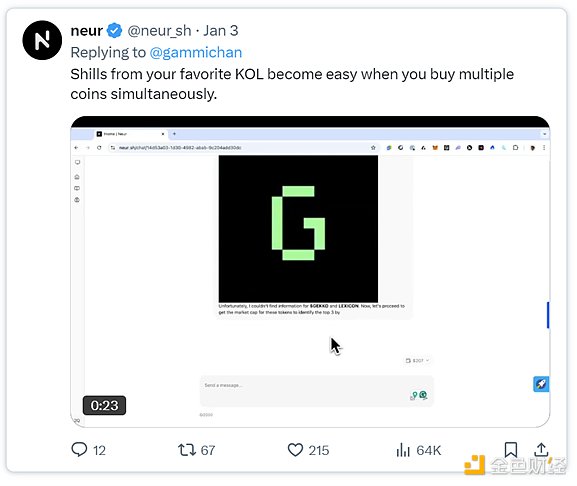
I personally use Slate, it's still in the early stages and no tokens have been released yet, but I like the automation features. I mainly use it to set up conditional trades, such as selling 25% of the position if [xxx] reaches the market cap of $5 million, or buying $5,000 worth of tokens if [xxx] reaches the price of [xxxx] currency.
Wayfinder Foundation is another interesting application worth keeping an eye on. It's a behemoth that the PRIME/Parallel team is building.
2. Independent trading agent
Why spend hours mining alpha, manually executing trades, and trying to optimize your portfolio instead of letting an agent do it? Autonomous trading agents are taking the concept of trading bots to the next level, turning them into dynamic partners that can adapt, learn and make smarter decisions over time.
It needs to be said that trading bots are nothing new. They are based on static programming to perform predefined actions and have been around for many years. But proxies are fundamentally different:
-
They extract information from unstructured, ever-changing environments.
-
They reason about data in the context of a target.
-
They discover patterns over time and learn to exploit them.
-
They can perform actions that were never explicitly programmed by their owners.
This segmented industry is developing rapidly. What started as entertainment purposes has now transitioned into practical, profit-driven tools that help users trade more efficiently. However, there's an important challenge here: How do you verify that an " agent " is not just a robot, but even a human being operating everything behind the scenes?
This is where DeAI infrastructure comes in.
The role of DeAI in verification agents
Critical infrastructure like the Trusted Execution Environment ( TEE ) ensures that agents operate securely and cannot be tampered with.
For example:
-
TEE : TEE is promoted by Phala Network and provides secure enclaves, and the data is treated confidentially. Phala’s experiments – like Unruggable ICO and Sporedotfun – show how agents can perform tasks while maintaining data integrity.
-
Transparent Execution / Verification Framework : Innovative technologies like zkML (zero-knowledge machine learning) or opML provide verifiability of inference and computation. Hyperbolic Proof of Sampling ( PoSP ) is a prominent example. This mechanism combines game theory and sampling to ensure accurate and efficient calculations in a decentralized environment.
Why is this important?
When autonomous agents start handling large amounts of TVL—imagine $100 million or more of TVL—users will have extremely high assurance requirements. They need to understand how the agent manages risk, validate the framework they operate under, and ensure their funds don’t end up in any random meme coin.
This area is still in its early stages, but we see some promising projects exploring these verifiable tools. This is something to keep in mind as DeFAI evolves.
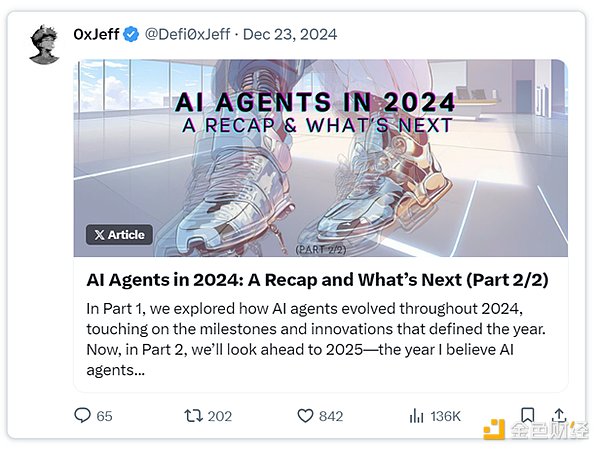
Top Autonomous Trading Agent Projects I’m Following Closely
as follows:
( 1 ) Almanak
Almanak provides users with institutional-grade quantitative AI agents that solve the complexity, fragmentation, and execution challenges of DeFi.
The platform forks the EVM chain and performs Monte Carlo simulations in a real-world environment, taking into account unique complexities such as MEV, gas costs, and transaction order. It uses TEE (Trusted Execution Environment) to ensure the privacy of policy execution and the security of alpha insights, and supports non-custodial fund processing through the Almanak wallet, allowing precise permission authorization for agents.
Almanak infrastructure supports the conception, creation, evaluation, optimization, deployment and monitoring of financial strategies. The ultimate goal is to enable these agents to learn and adapt over time .
Almanak raised $1 million in LEGION, which was heavily oversubscribed. Next steps are beta release and agent deployment/initial strategy for beta testers. It will be interesting to see how these quantitative proxies perform.
( 2 ) Cod3x/Big Tony
Developed by the Byte Mason team (known for their Fantom/SonicLabs work), Cod3x is a DeFAI ecosystem designed to simplify the creation of trading agents. The platform offers a no-code development tool that allows users to create agents by specifying trading strategies, personalities and even tweet styles.
Users can access any data set and leverage the API and strategy library to develop financial strategies in minutes. Cod3x integrates the Allora network and uses its advanced ML price prediction model to enhance trading strategies.
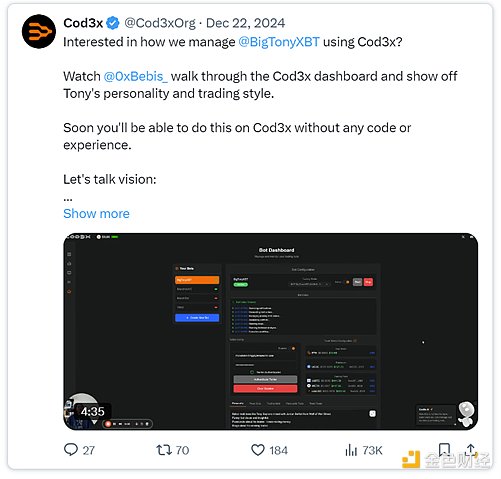
Big Tony is the flagship agent for trading based on the Allora model, with entries and exits based on its predictions. Cod3x is working hard to create a thriving autonomous trading agent ecosystem.
One thing worth noting is Cod3x’s liquidity approach. Unlike the common alt:alt LP structure promoted by Virtuals, Cod3x uses a stablecoin: alt LP structure powered by Cod3x’s own CDP (Collateralized Debt Position) cdxUSD.
Compared to the volatility of alt:alt trading pairs, this adds more stability and confidence to LPs (liquidity providers) when providing liquidity.
Cod3x also has its own DeFi primitives, such as Liquidity AMOs and Mini Pools, which deepen liquidity and add more functionality/DeFi building blocks to the agents in its ecosystem.
Notice:
- Axal/Gekko AI - Axal's auto-tuning product where agents handle complex multi-step encryption strategies. Gekko integrates automatic tuning functions. I'm looking forward to seeing how Gekko's integration with Auto-Tune performs data-driven trading.
- ASYM – Described by many as the “cheat code” for meme currency trading, the ASYM agent is able to analyze large data sets from blockchain and social media to predict meme currency trends. ASYM has consistently outperformed the market. ASYM has proven 3-4x returns through backtesting. Really looking forward to seeing how it performs in live trading.
- Project Plutus - I really like the name PPCOIN.
3. AI - driven dApps
AI-driven dApps are a promising emerging area in the field of DeFAI. They are fully fledged decentralized applications that integrate AI or AI agents to enhance functionality, automation and user experience. While this space is still in its early stages, some ecosystems and projects are already starting to stand out.
One of the most active ecosystems in the space is Mode Network, an L2 ecosystem designed to attract high-tech AI x DeFi developers. Mode already has several teams working on cutting-edge AI use cases:
-
ARMA : Developed by Giza, it customizes independent stablecoin farming strategies based on user preferences.
-
Modius : Autonomous agent farming Balancer LP, powered by Olas.
-
Amplifi Lending Agents : Developed by Amplifi, these agents integrate with Ironclad to automatically trade assets, lend on Ironclad, and maximize returns through automatic rebalancing.
The core of this ecosystem is the native token MODE. Token holders can stake their MODE tokens to obtain veMODE, which provides airdrops from AI agents, project whitelist access, and additional ecosystem benefits. Mode is positioning itself as an innovation hub for AI x DeFi and expects its influence to grow significantly in 2025.
In addition, Daniele published the DeFAI theory through HeyAnon , which caused a sensation.
He announced that HeyAnon is working on:
-
As an abstraction layer for DeFi interfaces
-
DeFi proxy for autonomous trade execution
-
Research and communications agents for acquiring, filtering and interpreting relevant data
The market responded enthusiastically, with the market value of ANON tokens soaring from US$10 million to US$130 million. Daniele seems to be bringing back the excitement of TIME Wonderland, but this time with a stronger foundation and a clearer vision (hopefully).
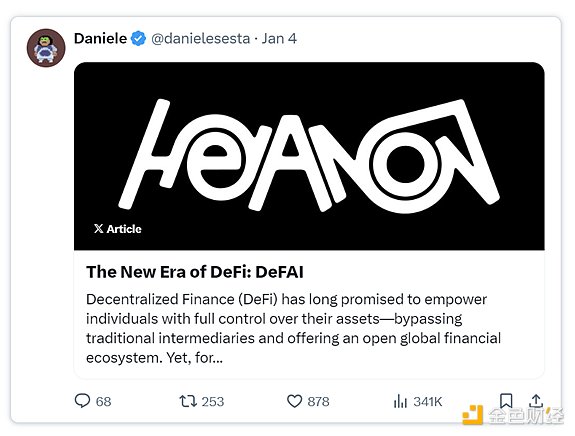
In addition to these two ecosystems, there are many teams building their own artificial intelligence dApps. I will share more in the future once the main ecosystem around these dApps forms.
Conclusion
DeFAI is changing DeFi, making it smarter, simpler, and more accessible.
With abstraction layers simplifying user interactions, autonomous trading agents managing portfolios, and AI-driven dApps optimizing use cases, we are seeing the dawn of a new era.
This is not a reappearance of the DeFAI Summer of 2020, but the DeFAI Summer of 2025!

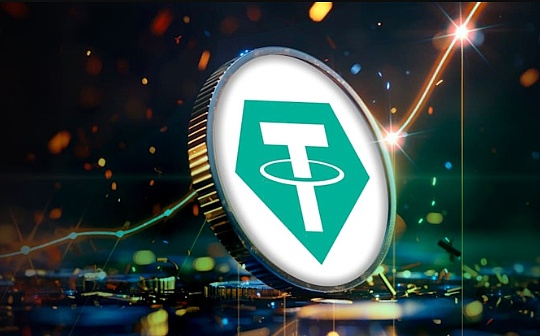

 chaincatcher
chaincatcher
 panewslab
panewslab